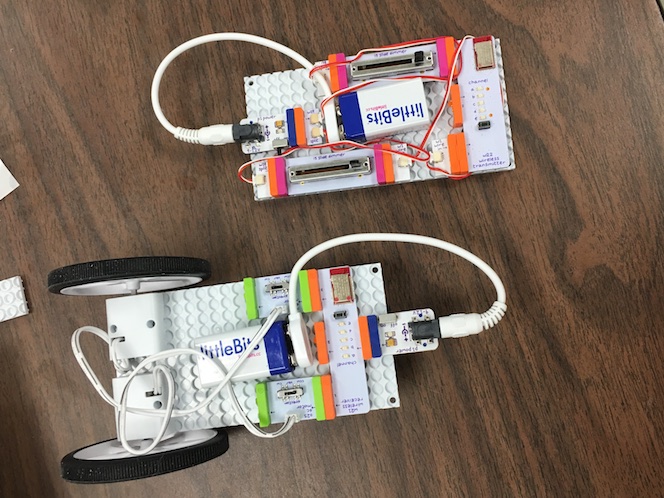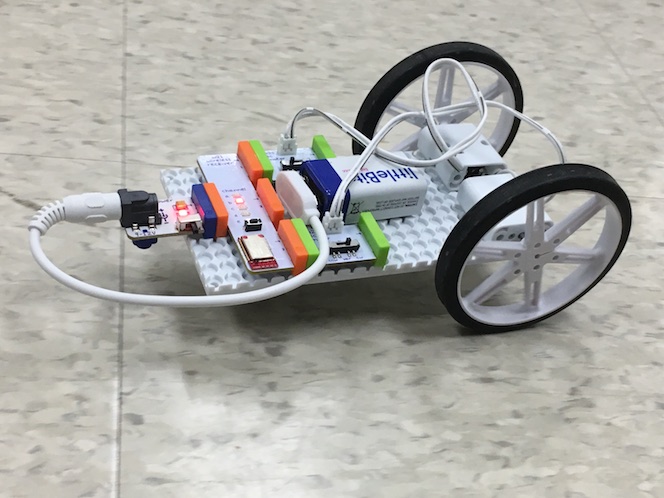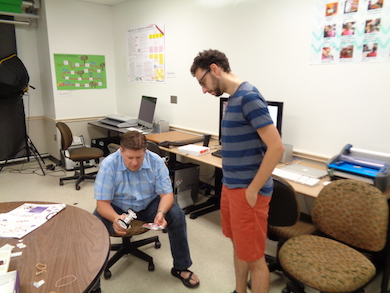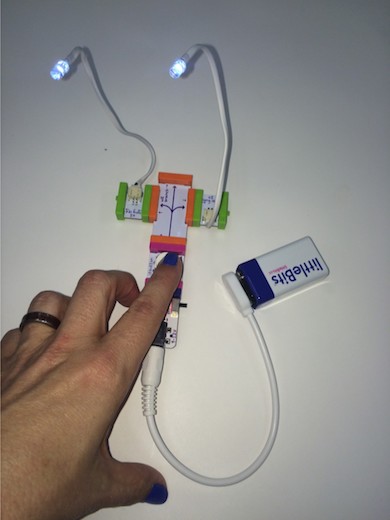Playing and Experimenting with littleBits
[W]e try, we fail, we revise, we try again, we fail in a different way, we get feedback, we revise, and so on. Failure is how we learn to write; failure is how we learn to impact society. (Carter, 2016, p. 391)
As we've described, the initial charge to the five graduate students in this class was to open the littleBits boxes and play—and not just to play once, but to engage in serial play over a period of days using these materials to create, remix, and redesign. We initially sat around tables in the Texas Tech English Department Media Lab looking at each other, somewhat unsure how to proceed. But slowly we began to unpack, both literally and figuratively, the five littleBits kits. Our littleBits exploration included viewing, touching, and handling the materials; reading the invention guides that came packaged with the kits; watching YouTube videos of users sharing their littleBits inventions; watching littleBits creator Ayah Bdeir's (2012) TED Talk; and, of course, creating littleBits projects.
Through our process of exploring composition and technical writing through littleBits, we grounded our journey in the idea of play. As we embarked on our voyage of discovery, our team allowed ourselves time to discover how littleBits worked. As a group, we were able to encourage each other, to provide guidance and ideas, and to offer assistance when we inevitably were stumped by the task at hand. Each team member approached our project differently. For some of us, composing with littleBits felt intuitive—characterized by easy investigation and experimentation. Using the color-coded circuitry and plastic components parts, these individuals soon had wheels spinning, lights shining, and buzzers buzzing. Others of us were not so quick to dive in: Some students took kits back to the privacy of their hotel rooms where they could read the directions in a quieter space and assemble inventions methodically while reading the directions step by step.
In our play, we placed the littleBits technology at the center of the composition process. In order to fully understand how the technologies contribute to our invention process, we started from ground zero—exploring and playing with littleBits to develop a new practice of composition. We were learning to play with the composition process by using technologies that we may not have normally considered technologies appropriate for composing. This process challenged and broadened our received definition of composing. We were, in Jody Shipka's (2011) words, "composing texts comprised of materials that, given the composers' histories of text production, represented new and uncharted territory for them" (p. 62).
In this section, we explore three different approaches we took to playing with littleBits: 1) the tinkerer's approach, 2) the architect's approach, and 3) the scientist's approach. While individual team members gravitated toward a single specific approach, as outlined below, we challenged ourselves to try different approaches through experimenting and playing with different ideas and approaches to solve new problems. All of our team members dabbled in each of the three approaches that we discuss below, stepping outside of their comfort zone and playing with new ideas. We provide an example of our playing that we see as representative of each approach.
The Tinkerer's Approach: Building a Car
Those of us who took a tinkerer's approach were ambitious, not afraid to test through trial and error and experimentation. One such example in our group came from the initial construction of a small car. Jack and Rick wanted to begin by immediately building something. They began by experimenting with the littleBits, testing different combinations and new ideas. While they eventually turned to the guides for additional instructions, they were not limited by the presented information and wanted to continue to build and play after their first project had concluded. As they were constructing the car, they simultaneously experimented with the littleBits, broadening their understanding of their functionality and their capabilities.



This tinkering led to an awareness of the limitations of the littleBits. One challenge that was revealed during this phase was that some of the littleBits components, especially those with moving parts, had issues staying connected during motion. Once the remote control car began to move, the vibration of the rubber wheels would sometimes pop some pieces (like the battery or the wheel itself) off of the connecting board. Clearly, the wheels or battery popping off the machine was a major issue for a device meant to be driven around. This challenge was solved through the use of copious amounts of tape. We also changed the initial design in order to reinforce the connection between the pieces. For example, instead of trying to connect the battery pack to the car with tape, or align it as it looked in the instructions, we moved the battery to the "inside" of the car, sandwiched between the upper and lower connecting boards. In this way, the battery simply "sat" in the car, stuck in place between the two connecting boards. The remote control challenges, however, led to the car moving in circles or in reverse. This was solved through the use of wires to reverse the direction of the slide dimmer, which allowed us to create a more intuitive interface for controlling the movement of the car. Jack and Rick's "messing about" (Franz & Papert, 1988, p. 409), then, mirrored the sort of tinkering advocated by Massimo Banzi (2011) and David M. Rieder (2017): They solved problems through playing with "a limited set of elements" (Rieder, 2017, p. 41).
Wanting to document this process, Jamie video recorded Jack and Rick's experiments. The trio documented their testing phase and test drove the car around the Texas Tech campus, experimenting with the range of the wireless controller, the functionality of the car over different surfaces and terrains, and confirming the durability of the car, specifically considering the challenges with construction.
The Architect's Approach: Building a Writing Machine
Some team members elected to approach the littleBits somewhat more cautiously. Instead of jumping in, the architect's approach began with reviewing the materials provided by littleBits: How do they work? What do the different pieces do? What are some possible combinations? What can we do with them? By approaching littleBits through the lens of an architect, these users were able to methodically build new inventions and learn how littleBits functioned through guided instruction. Architects carefully plan out their project. They outline a project, select ideas and resources, and finally execute the project. Architects focus on the big picture: envisioning what their final product will be and planning accordingly.
Leslie and Andrew decided to follow some basic instructions to build a writing machine, as outlined in the littleBits documentation (littleBits STEAM Student Set Invention Guide, 2006, p. 39). They first identified all the necessary materials, then planned out who would build what parts, prepared the extra materials (paper and markers), and finally, began to build. The construction process went smoothly, as the requisite pieces and materials had already been collected and organized. As the pair was building, they discussed each littleBit piece, developing their understanding of how the component worked, what it could do, and what its limitations were—a process of invention similar to Rieder's (2017) heuristic for inventing with physical computing, where he suggested rhetors start by researching "the technical characteristics" of components and how they work (p. 47). During each phase of construction, the team tested to ensure that it was being constructed properly and that there were no unanticipated issues.
As can be expected with testing, there were failures in development. Just as Rick and Jack experienced in the construction of the car, Leslie and Andrew encountered issues with the construction of the writing machine. During the first test, the marker fell off, rendering the device useless. The solution: additional rubber bands and tape to hold it in place. During another test, the wheels spun, yet the device didn't move; we needed to improve traction by changing the writing surface from a poster board to a newspaper taped to the floor. During our final test, the machine worked. It was able to successfully write on the newspaper in a sporadic manner! One of the challenges that we did not anticipate was that the writing machine, while it generally moved slowly, sped up at times, quickly escaping from the newspaper and beginning to write on the tile floor in the English Department Media Lab; luckily, the marker was not permanent and we were able to add this experience to our repertoire.
The Scientist's Approach: Making the Googly Eyes
The scientist's approach blended careful observation with experimentation and testing. Team members that approached our project in this manner spent time observing and learning about the littleBits prior to attempting to construct something. These individuals focused on building small pieces, testing, adding on, and conducting additional testing. While they also followed the instructions to build new constructs, they focused on constructing smaller pieces to start off, in order to familiarize themselves with different aspects of littleBits.
The scientist's approach to developing a new media project may appear to be disjointed or unorganized to observers because it may seem like the is scientist working with small, discrete projects that don't cohere as a single, cohesive composition. However, the scientist's approach is in fact a bit methodical: testing individual pieces of the composition to see how it functions, evaluating components and methods, and deciding whether to continue or to go back to the drawing board. This process consists of many micro-level plans and objectives.

One project that exemplifies this approach was the googly eyes, a project presented in one of the littleBits guides. Jamie carefully observed, recorded, and planned her constructions. She methodically approached each project, paying close attention to how the project should function and to how the pieces were used. In one instance, she selected a kit, examined each piece, and began testing during the workshop time. Later that evening, she continued to experiment and build. By the next morning, she had constructed the googly eyes and had multiple ideas of how it could be used for different projects and how we could improve the documentation and the supporting materials.
Packing Up: Play as Recurrent Failure
Our play with littleBits was marked by recurrent failure. While at times this failure was frustrating, it was also productive. We learned from failure, built new problem-solving approaches, forged ahead, and failed more throughout the process of making with littleBits. We're reminded of James Paul Gee's (2003) argument that formal education has much to learn from videogaming, an argument that echoes Seymour Papert's (1993) constructionism: Whereas traditional education typically focuses on the end goals and solving problems quickly—"Good learners move quickly and efficiently toward their goal" (Gee, 2003, p. 164)—videogaming relies on a different model. Gee explained that when video gamers defeat a boss too easily, they often repeat the game stage at a higher difficulty level. For video gamers, difficulty is important: "hard is not bad and easy is not good" (p. 165). We see parallels here in playing (and failing) with littleBits. Part of what made playing with littleBits so enjoyable was the challenge of making something new. This challenge involved experimentation and recurrent failure. And further, just as Gee explained how videogames scaffold learning, providing opportunities to practice skills that are later transferred to new scenarios, making with littleBits involves scaffolding, moving from less complex to more complex constructions.
We close this section by suggesting that innovation occurs when students are allowed to play and fail—whether with three-dimensional objects or with traditional essayistic composition. Play, we should stress, is not so much an activity, but rather "a state of mind" (Brown, 2010, p. 60). Play involves being absorbed in an activity so that one can take risks, and innovation and discovery happen when one "is willing to risk losing control over his or her work," which allows him or her "to make discoveries, stumble on happy accidents" (Sennett, 2008, p. 113). The promotional video that we created for class perhaps highlights the enjoyment we experienced while playing with littleBits, and while it includes some successful inventions (such as the chicken, which we discuss in the create section), it also includes scenes of us learning with littleBits and a few failures (or near failures). The rotating lamp we invented is off-balance, the writing machine stutters, the remote control car doesn't always drive smoothly. As Rick stated at the end of this video, "Failure breeds innovation."
(Note: This video uses the song "Fun" by Akashic Records [2013], used under a purchased Jamendo license.)